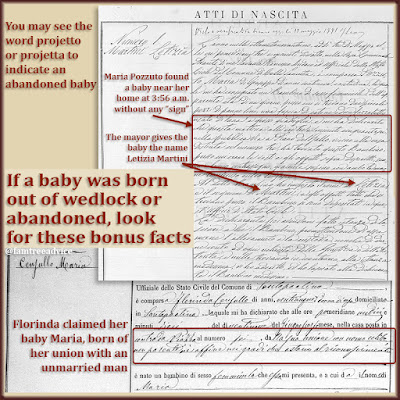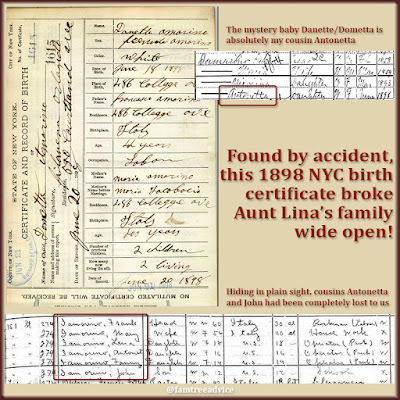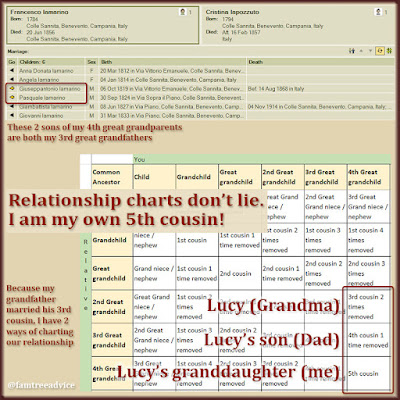I'm nearing the end of my mega-genealogy project. I'm reviewing every available vital record from my grandfather's hometown. Then I'm fitting almost everyone into my family tree.
As I journey from 1809 to 1942, I'm noticing that most couples had far fewer babies in the 1870s than they did before. Instead of 12 babies, they had about five. Did they finally discover how not to get pregnant every year?
I've also noticed 9 types of facts that you can easily overlook on certain birth records. How they recorded these facts depends on the place and the year. Once you know they might be there, you can be on the lookout.
This article was running long, so here are the first 5 bonus facts. Please come back next week for the rest.
1. Abandoned baby
Birth records for abandoned babies may be found with all the other births that year. Or you may find them listed in a group at the end of the birth records. These records may have details about who found the baby and where, and what they found with the baby. Was the baby naked? Wrapped in rags? Wrapped in a nice blanket? Was there some small token with the baby?
If a mother hoped to claim her baby later, she could leave behind a sign. She could wrap it in a blanket that only she could describe. She could include a picture of the Virgin Mary, or something that only she knew was with the baby.
You'll see wording to say that they "gave" the baby this first name and this last name. And you may see who will raise the child.
 |
| If someone in your family tree was abandoned or born out of wedlock, don't overlook these important facts. |
2. Baby born out of wedlock
A woman had to be pretty brave in a Catholic community to claim her out-of-wedlock baby. But it happened. In this example we see that 25-year-old Florinda claimed her baby Maria who was born:
This translates to: from her union with an unmarried man who is not her relative nor of any close relationship to her.
Sometimes you'll see the words unione naturale, which is a nice way to say the baby was not conceived by a married couple.
3. Marriage date of out-of-wedlock baby's parents
There are times when a man will claim his out-of-wedlock baby, but not give the name of the mother. This is a lot less common than a woman claiming her baby and not naming the father.
Sometimes the birth record will have a note stating the other parent's name, and when they married. What a bonus!
In the example of Cristina Iamarino, her father Donato claimed her but didn't name the mother. Like the example above, we see:
This tells us his baby was born from his union with an unmarried woman who is not his relative nor of any close relationship to him.
The note in the column says that 5 months later, Donato married Antonia Paolucci—the baby's mother, legitimizing their baby.
 |
| This jaw-dropping bonus in Cristina's birth record gives the name of her missing mother! |
I find it interesting that Cristina's marriage notation shows she married an abandoned baby with a made-up name.
4. Stillborn baby
There seemed to be a lot of stillborn babies in the towns where my ancestors lived. The idea of a father carrying the dead baby into town to present to the mayor is horrifying. But that's what happened. (See Why Our Ancestors Marched Hours-Old Babies into Town.)
On these records we see these Italian words right after the baby's first name:
This translates to, "and that I know myself to be lifeless." That's the mayor (or their clerk) saying they see for themselves that this is a dead baby. (God help me, that makes me think of Monty Python's dead parrot sketch.)
Look for the words senza vita (lifeless, or literally, without life) written near the given name, or nato morto (stillborn, or literally, born dead!) written in the column. It always pains me when I see a couple having more than one stillborn baby.
 |
| Always look near the baby's name for senza vita, or in the column for nato morto or a death date. This bonus fact is easy to overlook. |
5. Baby's early death
When death records aren't available, it's helpful to find a death date written on the birth record. This tends to happen when a baby died very soon after birth.
In this example, Pasquale Iamarino was born on 2 April 1912, and the note says he died on 14 April 1912.
Next week's article, "9 Bonus Facts Found on Italian Birth Records, Part 2," includes a bonus that's new to me. It's something I'd always wished they would include. And sometimes they do!



